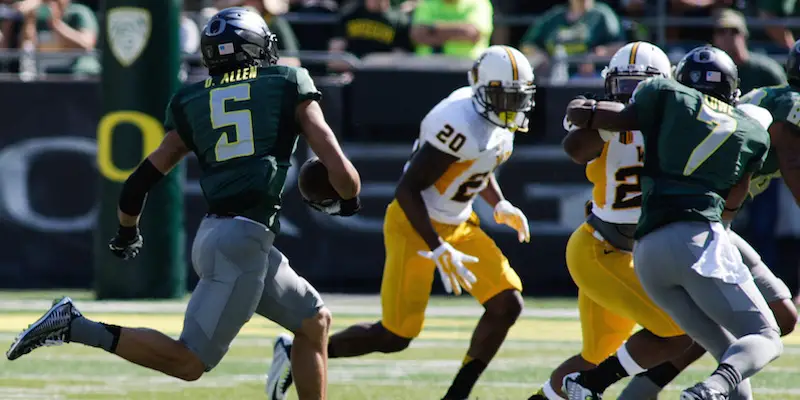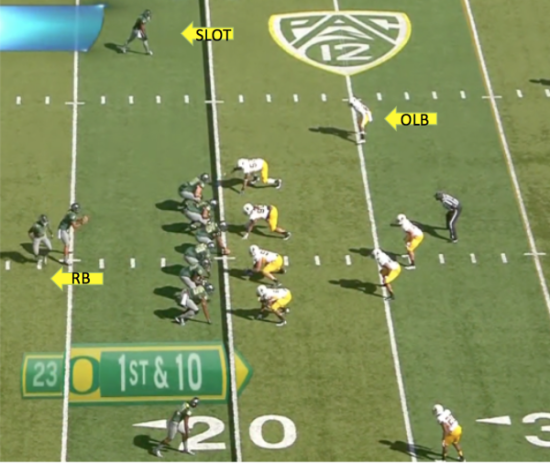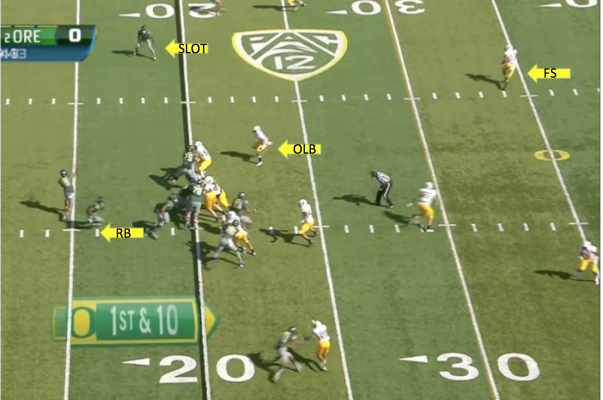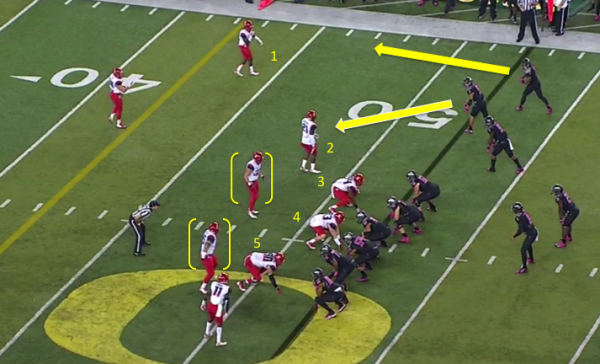The High Powered offense of the Ducks is predicated on many different facets, one of which is taking the easiest means necessary to move the football. At any point in the game, this Fast Screen can take flight. The Ducks want a high percentage play that will get yards and keep the defense guessing, and while the Fast Screen is not a new concept, it has become a staple of the Ducks offense. Running the Fast Screen at a fast pace creates a nightmare for opposing teams and coaches. When the Oregon coaching staff discuss on their headsets what plays to call next, there will always be a coach looking to call the Fast Screen.
Above, you can learn more of how the Fast Screen works from a coaching standpoint and improve your understanding of the concept. The above picture shows the offensive spread formation, which has two receivers on both sides of the football as the defense is aligned in a traditional 4-3 formation. This demonstrates the action of the Fast Screen from a bird’s eye view. This will also put you in the same seat as the coaches and players when they are in the meeting room installing the play for the first time.
In the picture above, you can see the concept of the fast screen to Keanon Lowe, which is essentially getting the football in an athlete’s hands as quickly as possible. Lowe is in slot position prior to the snap and Marcus Mariota is looking at the outside linebacker for a Fast Screen read. The space between Lowe and the OLB called for Mariota to pull the trigger, since Mariota considered Lowe to be uncovered. The term uncovered refers to an offensive player who has no defenders in his general area.
The picture above shows the running back Thomas Tyner, who will motion from left to right, forcing the OLB to adjust his alignment due to his concern for a run play. The fast pace set by the Ducks forces the decision making process to be much more difficult for the defense. Also, the motion will allow Mariota to make a more sound judgement. With the multitude of attacks from the Ducks, it is extremely hard to decipher what play is coming.
The Fast Screen is essentially a run play that can gain a large amount of yardage.
In the picture above, Tyner sold the fake as Mariota released the football. This froze the Cowboy OLB, which created more space for Lowe to gain yardage.
Click on the video links to see the process in action. You will notice that even though Lowe gained only 3 yards, the defense now has to account for this type of play for the duration of the game. Notice what the other offensive linemen are doing. The left guard is pulling to the right, which forces a linebacker to attack the run as the middle linebacker quickly identifies the Fast Screen. You must pick your poison with the Ducks in this case — “Do we stop the run or the pass?” begs the question by all defenders.
The video above shows even more creative methods of using the Fast Screen to gain yardage and catch a defense off guard. This particular play has the Ducks showing what is called an unbalanced look. In this play, Byron Marshall and Keanon Lowe are blocking for Darren Carrington. The flash ball fake by Mariota to running back Tyner yet again froze the interior of the defense, allowing more space to gain positive yardage.
Lastly, take a look at yet another formation. In the screenshot above, each Duck is matched up to position block an Arizona defender. A position block by design is used to get in the way of the defender to create more space for Marshall. Each blocker is merely trying to escort the defender away from the play using the defender’s own momentum. Each linemen is matched up evenly to their Arizona defender to prevent any type of defensive run though — this is demonstrated by the numbering of the defense.

It is the same as a running play.
When counting the number of Ducks blocking the number of defenders, you will find that the Ducks have ample personnel to maintain quality blocks. The two linebackers failed to account for the fake run, which led to a successful Duck play.
In the future, we will discuss complementary plays that will build-off the Fast Screen concept. As the Ducks coaching staff continues to be creative with play calling, defenses will continue to struggle with learning how to stop this type of attack.
I may be in Kentucky, but “oh how we love to learn about your beloved Ducks!”
Jeremy McGuire
Oregon Football Analyst for CFF Network/FishDuck.com
Lebanon, Kentucky
Top Photo by Gary Breedlove
In his tenure as football coach he has had the opportunity to coach in 5 State Championships, winning 3. As the high school game continued to change, Jeremy began to study the Ducks style of play beginning in 2007. Jeremy took some time away from High School football to begin a career in School Administration. Football was never far from his thought as he continued to help local High School Coaches with game planning. After spending 5 years in School Administration Jeremy had the opportunity to start a Graphic Design program and get back into High School full time. Relocating to Lexington, Ky. Jeremy began coaching at Frederick Douglass High School. Jeremy was able to fulfill another goal by coaching his own son who is also a member of the Douglass Broncos. Over the past two years, this 6A powerhouse has a record of 20-4 winning back to back District Championships. His career has come full circle as he is now calling the defense for the Freshman team that is made up of over 30 players each of he 2 years he has coached. He also stays with his roots and works with skills players on offense for JV and Varsity. There are over 95 players on the Frederick Douglass team where Core values are at the center of their success.
As a former Campbellsville University quarterback, and over 20 years of coaching experience he is excited to provide football analysis with the FishDuck team.





